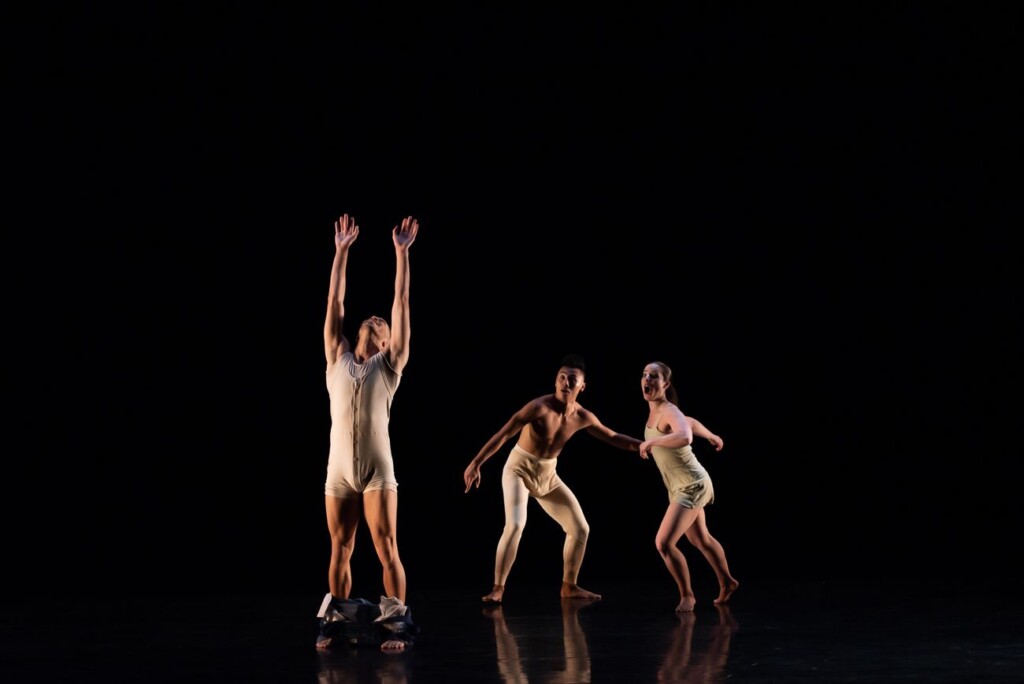SALT LAKE ACTING COMPANY: SLEEPING GIANT, BY STEVE YOCKEY
For connoisseurs of macabre stories with a generous twist of humor, like classics such as Supernatural, Tales from the Crypt, Creepshow, Shirley Jackson short stories or the geekdom culture of the Cthulhu folklore, Steve Yockey’s Sleeping Giant is a devilish delight.
The play’s world premiere production at the Salt Lake Acting Company (SLAC], directed by Emilio Casillas and Shawn Francis Saunders, is carried by a strong cast and features an ingeniously designed stage set.
Yockey is no stranger to SLAC audiences. Two of his plays were previously produced by SLAC: Blackberry Winter (2015) and Mercury (2017). Yockey, whose HBO Max series The Flight Attendant has been a hit among audiences and critics, premiered a shorter, earlier version at the Edinburgh Fringe. Last May, SLAC presented a reading of the complete script in its New Play Sounding Series.
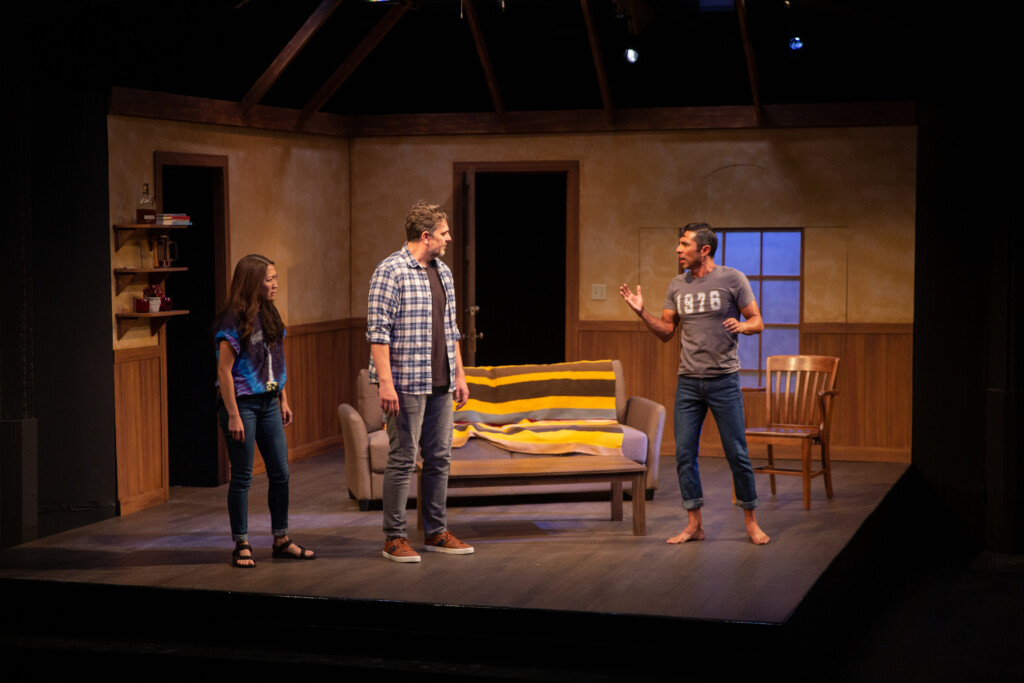
The play starts with a classic trope of horror: a cabin nestled in a remote area near a lake where a mysterious giant sea monster is believed to reside. Local folklore about lake monsters is found practically everywhere. Many Internet sites have documented sightings of lake monsters in the U.S. and the legends that have been conjured around them have become currency for tourism and local pride as well as speculation and fodder for campfire tales of fear and horror. Chessie, for example, which has been allegedly sighted in Maryland’s Chesapeake Bay periodically since the 1930s, has been neutered in some way to become that state’s environmental icon as well as the subject of coloring books and educational materials provided by the U.S. Fish and Wildlife Service. But, as Yockey teases us in Sleeping Giant, even a legend that has become innocuous or lighthearted might still have the power to stoke fear in the residents of lakeside communities.
In the opening scene of Sleeping Giant, during their vacation, the boyfriend proposes marriage to his girlfriend (with fireworks to boot) and from there things steadily become weirder and more eerie. There is the legend of The Butterfly King, part of a sacrificial cult which espouses cannibalism, as well as events involving strangers that seem disjointed at first but they eventually are threaded together into a narrative suggesting the deep influence and reach of the lake’s sleeping giant.
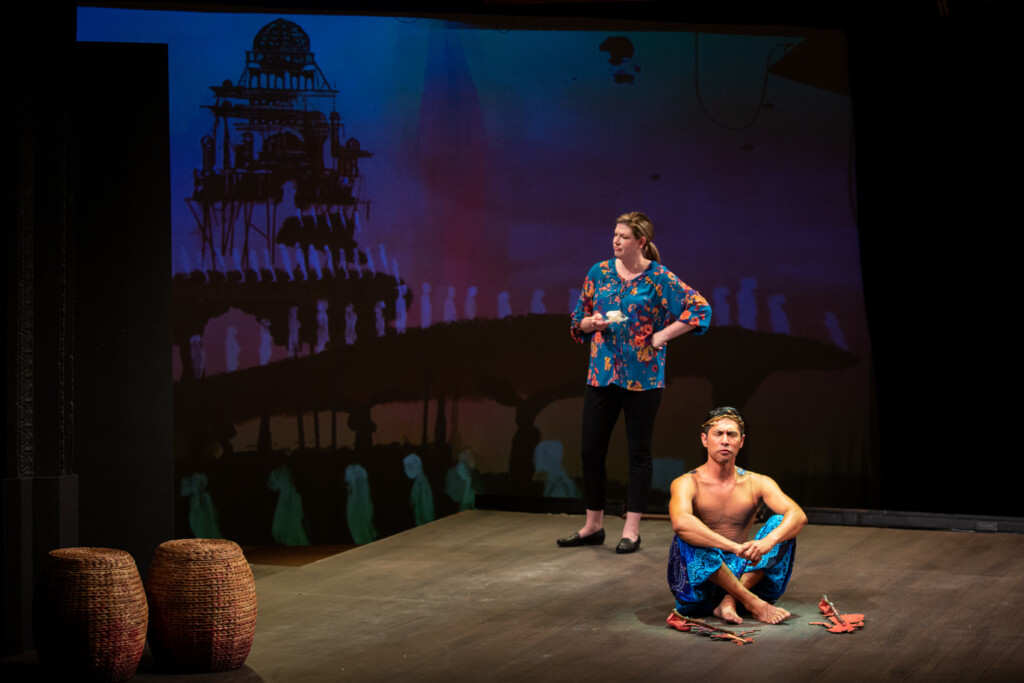
The cast dives into this horror comedy with the right doses of straight-faced seriousness, as they face the fears of their surroundings becoming more apocalyptic with every scene. Taking on multiple roles at various points, the actors skillfully mine Yockey’s script for its lurid gems: Lily Hye Soo Dixon (The Naïf), Tito Livas (The Messenger), Robert Scott Smith (The Raconteur) and Casssandra Stokes-Wylie (The Convert).
A major part of this theatrical fun is to embrace Yockey’s far-fetched rendering and plunge gleefully into this imaginative landscape, along with the actors who switch gears frequently in the emotional and comedic demands of their various characters. The play is a theatrical dance of counterpoint, sometimes absurd to the point of irrecoverable incredulousness and others with just enough credible realities to remind us why our brains gravitate toward finding the adrenaline-inducing sensations of stories from the darker side. This is particularly effective when we see the various characters in their most discomfiting moments.
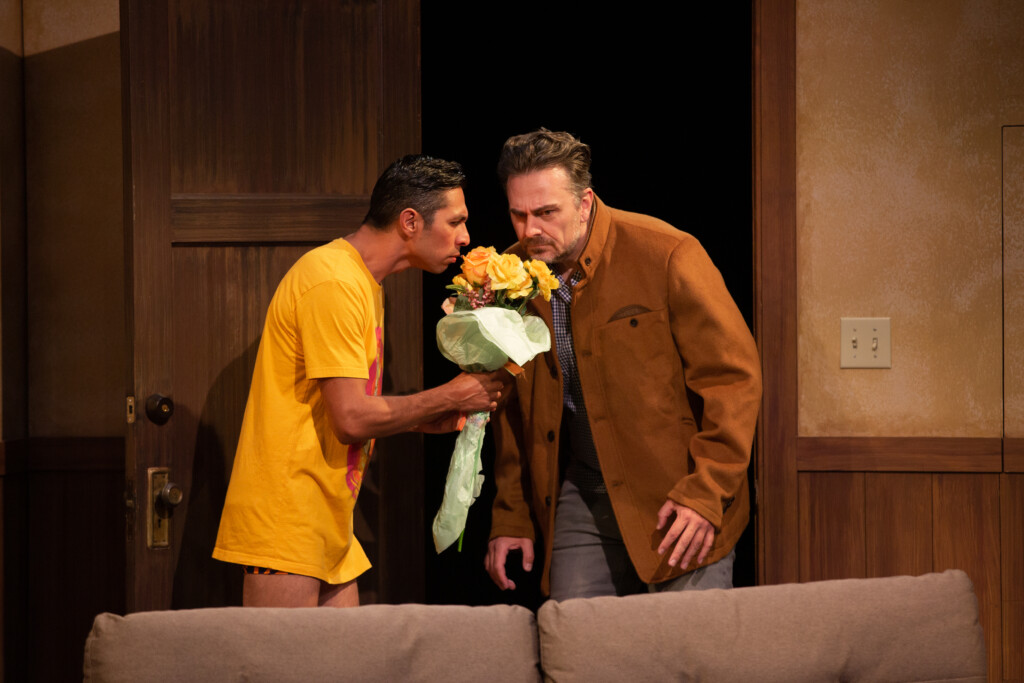
An apt parallel to the counterpoint unfolding on stage is the smart set design and construction, courtesy of Halee Rasmussen and Erik Reichert, respectively, which morphs into different settings but without disrupting the flow and pacing of the production. Likewise, other design elements amplify the eerie, weird elements of the play, thanks to the work of Bett Shouse (costume designer), Jessica Greenberg (lighting Designer), Cynthia L. Kehr Rees (sound designer), among others.
The production continues through Oct. 16. For tickets and more information, see the SLAC website.
RIRIE-WOODBURY DANCE COMPANY: PRECIPICE
Comedy is always difficult to achieve, especially in contemporary dance, but in the world premiere of LajaMartin’s The Bunker, the choreographic creation by Martin Ďurov and Laja Field, the objective was mastered brilliantly.
The work capped Precipice, the outstanding 59th season opener for Ririe-Woodbury Dance Company, which also included a reconstruction of To Have and to Hold, a 1989 work by Danial Shapiro and Joanie Smith, and the reprise of Everything that Changes (2013) by Daniel Charon, who has just begun his 10th anniversary season with the company.
LajaMartin, as noted previously in The Utah Review, are breathtaking in the visceral expression of their creations, which often are filled with the duo’s trademark elements including drama, romance, comedy, props and their consistently thrilling movement language.
The Bunker starts from an amalgam of pop cultural icons. Just imagine that Biosphere 2 meets reality TV classics such as CBS’s Big Brother, MTV’s The Real World, Bravo’s Below Deck and Vanderpump Rules, with RuPaul’s Drag Race thrown in for a bit of hot spicy tea. And, the six dancers (Peter Farrow, Megan McCarthy, Alexander Pham, Fausto Rivera, Sasha Rydlizky and Miche’ Smith) revel in the theatrical roles, which the LajaMartin choreographers have cast for them. In The Bunker, the dancers remind of the hippie theatrical group that became part of the pseudo-scientific venture called Biosphere 2 in the 1990s (which later was documented in an excellent Sundance film, Spaceship Earth). Despite morale which crumbled and the members had turned against each other as rivals throwing cups and utensils against each other, the greatest achievement of the experiment was the fact that the same number of people who went into the biosphere came out at the end. Happily, the same thing happens in The Bunker.

Ririe-Woodbury Dance Company.
Photo Credit: Stuart Ruckman.
Indeed, The Bunker demonstrates how human stability can unravel in a closed system but the comedic opportunities, which pop up in ample portions including text, live video images and stills, also emphasize, whether in art or in science, that one should never fear failure because otherwise it will stop someone from testing pioneering and enterprising ideas. The musical score includes smart, relevant samples including Bruno Mars’ Leave the Door Open, Rupert Holmes’s Escape (the Pina Colada Song) and Ďurov’s original remix of Journey’s Don’t Stop Believing. Overall, LajaMartin and the brave sextet of dance artists pull off The Bunker magnificently.
The dancers excelled equally in the complex physical demands of To Have and to Hold, which Shapiro and Smith originally set more than 30 years ago in memory of how relationships slipped away during the AIDS crisis. The restaging of the composition – known famously as “the bench piece,” acknowledging the prop central to it – set by Smith and Laura Virtucio, features a score by Scott Killian, a composer well known by many choreographers. The dancers truly captured the magnitude as well as the mournful sentiments of the work. The opening sections have a restless vivacious sense of human connection in full bloom but then the work transitions to a near-haunting realization among humans who hope that somehow in keeping memories of those who have passed on, their loved ones are still within arm’s reach.
Charon’s Everything That Changes, a work he set during his first year as the company artistic director and which coincided with Ririe-Woodbury’s 50th anniversary season then, was the perfect companion piece for this concert’s theme of Precipice. In 2022, the work, set to music by Max Richter, resonates just as properly as it did during its premiere. Considering the efforts a dance company endured in coming out of the pandemic and with an ensemble that has been remade in its near entirely over the last couple of seasons, this piece and its latest performance renew its original thematic message. It is an ebullient composition of perpetual motion, reminding us why Ririe-Woodbury continues to thrive on the precipice of its forthcoming 60th anniversary season.
REPERTORY DANCE THEATRE: QUADRUPLE BILL (PLUS)
For a dance institution such as Repertory Dance Theatre (RDT), the nation’s oldest dance repertory company of its kind, the epitome of resilience and longevity is found in Bill Evans, one of the most prolific choreographers among RDT alumni who was part of the company’s earliest years.
RDT’s 57th season opener, Quadruple Bill (plus), comprised entirely performances of works that Evans has created, spanning from 1973 to 2022. At 82, as an earlier preview at The Utah Review noted, Evans remains as active as ever, both as a performer and choreographer.
Five years ago, RDT had presented a concert of his works (Top Bill), and while this most recent concert included two works presented in 2017, this latest production proved to be a spectacular harmonizing of the legendary choreographer’s creative vision and the current generation of RDT artists’ capacity to execute an exceptionally demanding program with unflagging stamina and exquisite grace.
The first half of the program presented Evans’ work from its most dramatic and emotional dimensions. The opener was Petroglyph, featuring all nine RDT dance artists (Lauren Curley, Caleb Daly, Trung “Daniel” Do, Lindsey Faber, Elle Johansen, Jonathan Kim, Jacob Lewis, Megan O’Brien and Ursula Perry). This new work sprung from two earlier pieces that Evans had set for his eponymously named company (Sentinels, 2006; Naturescape Unfolding, 2012). Those earlier pieces were inspired by the Lehi, Utah native’s response to the spectacular imagery of southern Utah’s Zion and Bryce Canyon National Parks.
This latest work goes deeper, simulating with stunning credibility, the figures, narratives and activities found in the petroglyphs in Utah’s landscapes. As mentioned previously, the petroglyphs still are subject to educated guesses about their meaning in terms of spiritual, celestial and natural realms. But, Evans recreates quite literally with movement what many petroglyphs portray. There are numerous sections where the ensemble is separated into smaller combinations, which emphasize the narrative range of petroglyphs as a whole rather than as individual fragments. The score is as mesmerizing and transcendent as the dance movement, featuring music by Inlakesh and sounds recorded in nature. It also is as fascinating to watch the dancer’s facial movements and eyes as it is to sync the movement with the tone and rhythm of the music. At times, it seems hypnotic and trancelike, and the dancers never break focus or character.
Meanwhile, Hard Times, a work that Evans set in 1973 during his RDT tenure and which was last performed in 1985, proved to be the artistic stunner of the evening. Evans danced in its 1973 premiere, along with his colleagues Ruth Jean Post and Manzell Senters.
It is one of the most complex works in the RDT repertoire, because its emotional and technical demands for the three artists performing it require them to evoke and express the built-in tensions of the Appalachian hillbilly stereotypes and their counterpoints. There are many dualities of meaning. Butting up against the misguided belief of backwardness is the charm of nostalgia. Confronting the image of ignorance or redneck caricatures is plainspoken wisdom of the earth. The lazy rube stereotype is challenged by the unrelenting pace of sweat and toil, while stubbornness is both a strength and a source of frustration, which ends up sometimes being acted out in force and abuse.
For the closing night performance, the trio – Curley, Do and Lewis – executed the complexities with exceptional results. There is a roller coaster of emotional highs and lows, as Evans sets the characters of his composition as doing their best to survive The Great Depression and other setbacks during the 1930s. And, sometimes those characters falter in making the best of trying to keep their heads above water. The duet by Curley and Do lays bare an incident of marital abuse. Lewis’ solo wipes away the rube and bumpkin caricatures, challenging the audience to look anew at individuals who have been relentlessly confined to the unflattering aspects of eastern Kentucky stereotypes. And, then there is the playfulness of the three dance artists in instances that elicit chuckles from audience members.
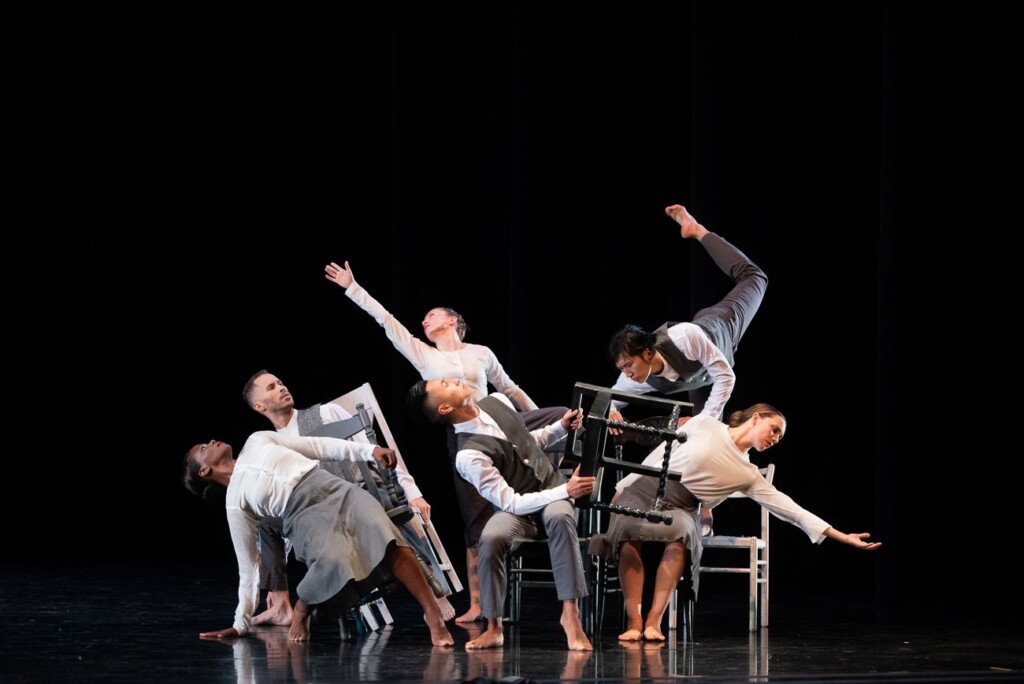
The trio in Hard Times provides one of the most memorable and compelling performances this critic has seen on an RDT stage. It stands, for example, with the company’s previous performances of Zvi Gotheiner’s Dabke. Evans curated an exceptional list of music for Hard Times, including reels and gospel songs, along with Milwaukee Blues by Charlie Poole and Norman Woodlief, which was recorded by the Deseret String Band. When the work premiered in 1973, the band performed live.
The second half of the concert flipped the mood. Suite Benny, created in 1988 and reconstructed in 2017, is Evans’ love letter to jazz, classic Hollywood musicals and ballroom dance. The nine company dancers looked as elegant and suave in their formalwear as they did in their movement, accompanied by songs written by Edgar Sampson and Louis Prima, in classic recordings by Benny Goodman and his orchestra. Ursula Perry, who now holds senior rank among RDT’s artists, was fabulous as the soloist, the perfect dance conductor to the counterpart of the band leader.
The concert bonus was Evans performing a solo tap dance with live jazz improvisational music by James Joseph Kaufmann. In 1988, Evans created Blues for My Father, as a tribute to William ’Ferd’ Evans who died in 1984. Later, he added a blues section that he has performed many times with Kaufmann. The audience, thoroughly elated with the performance, gave Evans some of the biggest, most sustained applause of the evening.
The closing work was Crippled Up Blues … and other tales of Deseret, a piece Evans created in 2015 to celebrate RDT’s golden anniversary. When the work premiered, it featured a live performance by the locally based 3hattrio, which composed the songs that Evans used. This work puts the exclamation point on the assertion that Evans – whether the work was composed in 1973, 1988, 2015 or 2022 – has consistently put formidable physical demands on the dancers but also with gratifying artistic satisfaction.
In this work, the dancers work with chairs as props and are put through more than a few passages requiring ramped-up athletic and even acrobatic skills. Meanwhile, they must convey a story that proceeds through scenes. Evans’ work asks for comprehensive memory detail in its storytelling. At times, the dancers exult in the fresh breezes that keep the valleys of Deseret clear so they can enjoy the views of the mountains. There are moments that also do not sanitize the history of Deseret, the occasional violence, the discovery of love, the vigilance to protect and preserve not just the integrity of Deseret’s natural wonders but also about losing the legacy of identity that marks the state’s unique pioneer spirit. it was the proper capstone to this concert. Evans’ love for Utah has not diminished one bit. And, the dancers graciously are carrying the legacy with their own appreciation.
A filmed version of the concert will be available Oct. 8 through Nov. 12. To purchase an option for streaming video on demand, see the RDT website.



